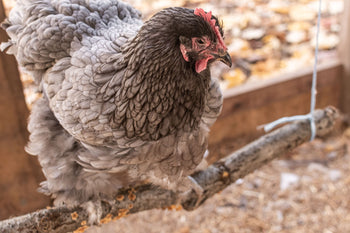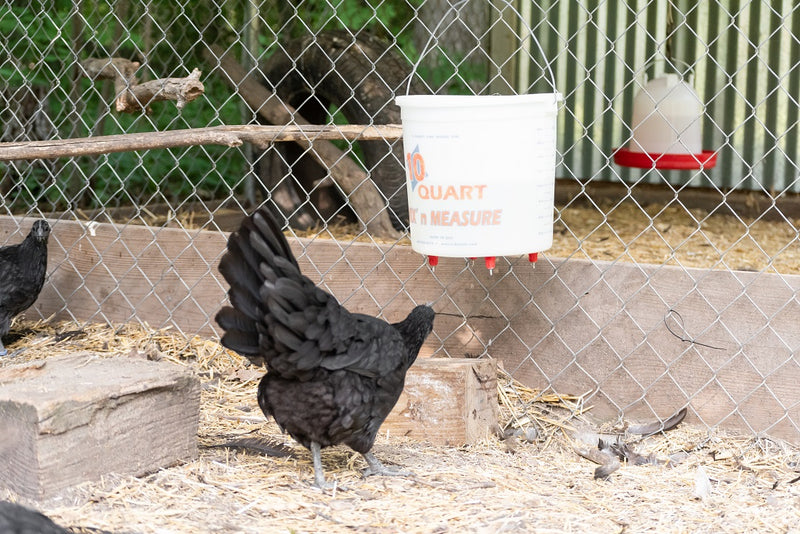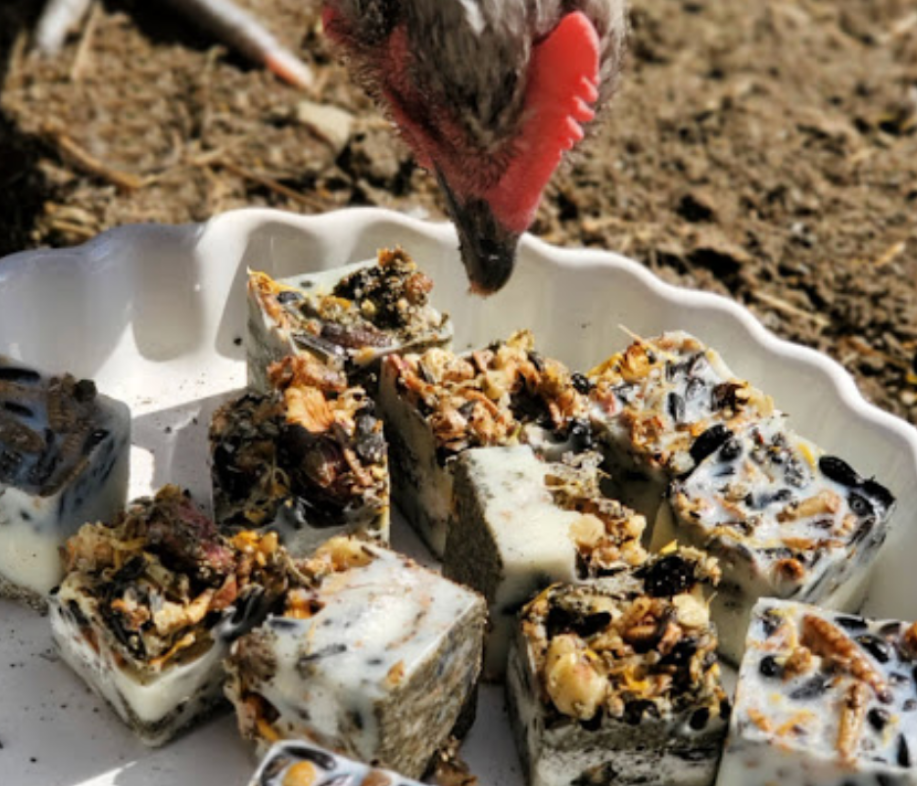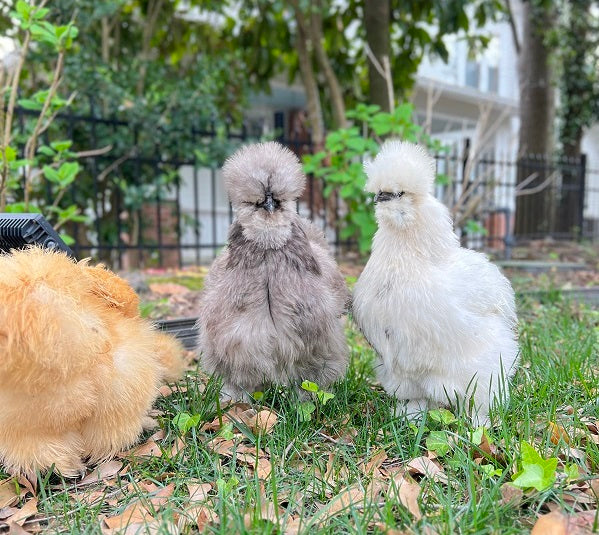Chickens are curious and active creatures. There are many skills that chickens are cognitively capable of achieving, and using a chicken swing is undoubtedly one skill that many chickens find enjoyment in doing! Chickens naturally have a playful and entertaining nature, and using enrichment activities, like a chicken swing, can help keep your flock mentally stimulated and physically healthy. Learn how you can provide your backyard flock with a chicken swing for their enjoyment and your own entertainment!

What Are Chicken Swings?
A chicken swing is a suspended perch that chickens can swing on. Chicken swings are very much like swings that we use, but instead of sitting, chickens perch on the chicken swing. You can hang a chicken swing in the chicken coop enclosure or chicken yard outside, where there is plenty of room for swinging.
Use your chicken swings to provide mental and physical stimulation for your backyard flock. Not to mention, watching your chickens use their chicken swing will be entertaining for you, too! Chickens are naturally curious creatures. Combine that with their love for perching, and a chicken swing is the perfect enrichment tool for keeping your flock active and mentally engaged. It is the ideal novelty to include in your chicken coop enclosure design for creating an enriched and entertaining space for your flock.
How Do Chicken Swings Help Chickens?
Chicken swings provide an interactive element for chickens by encouraging natural behaviors, such as flying, foraging for food, perching, and dust bathing. When chickens get to engage in natural behaviors on a daily basis, they are healthier and more mentally fulfilled.
A chicken swing engages the natural behaviors of flying and roosting. A chicken must fly up onto the swing, then balance and roost while it gently swings them back and forth. Many chickens quickly adapt to this 'moving perch' and find the swinging action relaxing.

Benefits of Chicken Swings for Your Flock
Physical Exercise- A chicken swing can provide an excellent way for your flock to get some physical exercise while being confined. Swinging on a chicken swing requires a chicken to exercise its muscles as it flies onto the swing and balances on the perch while it swings. Active chickens are less prone to obesity. Obesity can lead to health issues, a decrease in production, and make a chicken more prone to organ failure. Physical activity helps a chicken stay fit and healthy. Healthy, physically fit chickens will be more productive and mentally content.
Mental Stimulation- Chickens need to stay mentally stimulated. Lack of mental stimulation can lead to boredom and bad behaviors. When a chicken cannot engage in natural behaviors, it will resort to bad behaviors such as feather picking and bullying. Bored chickens are stressed chickens. When chickens are stressed, it suppresses the immune system, making them more susceptible to disease, and it makes egg production decline. A chicken swing engages a chicken mentally and stimulates natural behaviors, which can prevent stress from boredom or confinement.
Is It Easy to Build a Chicken Swing?
Chicken swings are an easy enrichment tool to build for your flock! You can fashion a chicken swing out of materials you may already have on hand. You just need materials to create a safe and sturdy swing for your chickens.
When building a DIY chicken swing, you will need to keep the safety of your flock in mind. Here are some factors to consider when choosing safe and sturdy materials for a chicken swing:
Rope- Choose a sturdy rope to hang your swing on. Ideally, the rope should be at least ½" thick in diameter. A sturdy rope will support even the heaviest birds in your flock when they want to use the chicken swing! The rope should not be frayed, worn, or prone to breaking.
Swing- The actual swing material should be grippy and flat. A slippery and round swing will be more challenging for chickens since they will have trouble balancing. Instead, the swing should be flat but not too wide. A chicken needs to be able to curl its toes partially around the swing to grip and stay balanced. The swing material should be grippy but not too rough.
If the swing is made from material that may splinter, sand down the swing surface so that splinters won't injure a chicken's feet. The swing should also be of sturdy material. If you use wood, choose green wood, seasoned wood, or treated boards to prevent the wood from becoming brittle and breaking.
Hanging- Consider how you will install the swing in your flock's enclosure or chicken yard. Hang the swing so that it won't fall under pressure. Use secure knots, such as stopper knots and figure eight knots, when fastening the swing to the rope and the rope to the surface you will be hanging the swing from. Using eye screws or looping the rope over secure beams are two options for safely hanging a chicken swing.

DIY Chicken Swings: Easy & Affordable
Not only are chicken swings easy to build, but they are also an inexpensive DIY project to make for your flock. They require minimal supplies and are simple to construct. The few supplies needed to build a chicken swing you may already have on hand, or they are usually inexpensive to buy at a local hardware store.
Minimal Supplies
Here are the basic supplies needed to make a chicken swing:
- Rope
- Swing (wood, branch, board)
- Eye screws
- Saw (for cutting swing)
- Drill & drill bit (slightly bigger than rope diameter)
- Measuring tape
- Scissors
It's possible to make simple DIY chicken swings without a saw, drill, or drill bit. You'll need a drill and drill bit if you plan on drilling holes at either end of the swing to fasten the ropes through. Alternatively, you can securely tie the ropes around each end of the swing. You may also not need the eye screws if you can hang the swing from a beam or sturdy branch that the rope can loop over.
Simple Construction
Building a chicken swing requires no advanced DIY skills! Whether you are crafty or not, making a chicken swing for your flock is possible! With a few simple steps, you can have a safe and sturdy chicken swing to keep your flock entertained and active.
Here are the straightforward steps for building a chicken swing:
- Cut the swing material to the desired size.
- Secure ropes to either end of the swing.
- Secure the rope from a structure or eye screws to hang the swing.
How to Make a Chicken Swing (Crafting Your Chicken's Favorite Hangout)
Now that you know how simple and easy a chicken swing is to create, you probably can't wait to craft your flock's new favorite 'hangout'. Here is a simple tutorial on how to make a DIY chicken swing for your flock!
Gather Your Materials
- Sturdy branch/board
- Saw (if needed)
- Sandpaper
- Sturdy Rope (½" diameter)
- Scissors
- Eye hooks
- Drill & drill bit (optional)
Assembling the Swing
- Cut branch/board to the desired size using the saw. A swing about 2-3 feet long is usually ideal, but you can make the swing as long or short as you think your flock will like. Cutting the swing may not be necessary if you already have a branch/board that is the desired size.
- If you use a branch or log, sand down the swing surface and remove any loose pieces that could splinter.
- Cut two pieces of rope to fasten to either end of the swing. The rope should be long enough to extend down from where you hang the swing with extra rope for tying knots.
- How to attach the rope to the swing:
- Option #1- Tie one end of each rope around either end of the swing. Use sturdy knots to secure the rope to the swing in such a way that the rope won't slip or come untied.
- Option #2- Drill a hole at either end of the swing using a drill and drill bit. The drill bit should be slightly bigger than the diameter of the rope you are using. Thread one end of each rope through the holes on either end of the swing. Knot the rope end with a stopper knot to prevent it from coming back through the hole when you hang the swing.
- How to hang the swing in the chicken yard:
- Option #1- Loop the ends of the ropes over a secure structure, such as a sturdy tree branch or support beams within the chicken coop enclosure. Tie the ropes off with secure knots that won't slip or come untied.
- Option #2- Fasten eye hooks appropriately distanced apart into a secure structure from which to hang the swing. Tie both swing ropes to either eye hook. Use secure knots to fasten the ropes so they won't slip or come untied.
Safety First
When installing the chicken swing in your flock's yard, there are some safety considerations. You don't want the swing to hit anything or any birds when in use. You should also do regular maintenance on the swing to ensure it is still safe and sturdy for your flock. Here are some safety tips to implement:
- Swing Height- Hang the swing about 18-24" off the ground. This may seem high, but it will prevent the swing from hitting birds on the ground when the swing is in use.
- Location- Hang the swing away from feeders, waters, walls, enclosure fencing, or other structures in the enclosure.
- Quality Control- Periodically check the swing for stability, swing strength, and knot/rope strength. Retie or replace ropes and knots that are not sturdy. Replace swings made from branches or logs if the branch or log is becoming brittle and might break.
Additional Tips & Fun Ideas
Your flock will soon love using their DIY chicken swing! However, there are other fun ways to change up your flock's swinging experience and make the swing even more engaging. First, you will have to introduce the swing to your flock.
Chickens are curious creatures, but they are often cautious about anything new and 'movable' in their space. Your chickens may seem scared of the swing at first. It helps to make the swing out of natural materials, like branches or logs, so there is a familiar element as part of the swing.

How to Get your Chickens to Use a Chicken Swing
Let your flock roam around the swing and get used to it being in their space. Feed them treats around the swing and purposefully move the swing so that the chickens get used to the swing moving, too. Once your flock is comfortable around the swing, a few curious and brave birds might try it themselves!
If not, you can encourage more friendly and bold hens to practice swinging. Gently place the hen on the swing and keep it as still as possible, feeding her treats while she's perched. After several times of not moving the swing, you can gradually start swinging it as the hen gets used to perching, balancing, and swinging.
Once one hen starts using the swing, the others will catch on fast! Pretty soon, you may have to make more than one swing! Additionally, here are some fun ways to change up your flock's swinging experience:
Adding a Twist to Your Chicken Swing
- Swing Variations- Offer different swings such as boards, wide pallets, dowels, and branches of various sizes.
- Add Color- Painting the swing can add a burst of fun color to your flock's enclosure! If nothing else, it's pretty for you to look at!
- Treats- Hang treats or herbs around the swing to challenge your flock to eat and swing at the same time. Or maybe they'll just enjoy the sweet aroma of the herbs while swinging.
Conclusion:
A chicken swing can provide mental and physical stimulation for your backyard flock, plus hours of entertainment for you as you watch your flock enjoy their swing! Chickens who are engaged in natural behaviors and kept active on a daily basis will be healthy and productive. The stress of boredom and confinement can be eliminated through enrichment activities, like a chicken swing, to improve your flock's daily well-being. Go ahead, make a DIY chicken swing for your flock and see how they like swinging!


















